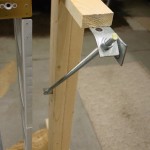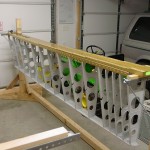Skeleton riveting complete
Hours: 5.0 | Posted in Spars & SkeletonCompleted the riveting of the wing skeletons by attaching the right rear spar to the ribs, and the forward rib tabs to the main spar…easy. I also took a trip to the store for some plywood to reinforce the wing jig, and built that. Ended up making a second trip, too, as I underestimated the amount of threaded rod I’d need to rig up the angles at each side. The threaded rod with nuts at each end allows for an easy adjustment of level.
Building up the jig went easily, if not necessarily quickly. I followed the general lead of Smitty, who details the dimensions and such he used in his build log. I built two jigs, so that both wings can be built at the same time. They’re also freestanding, rather than the plans type which have a post running from floor to ceiling; this was essential for me as I need to be able to get the overhead door open, and the posts would interfere. It’s basically 4′ legs, 5′ uprights, and 139″ on the beam, with reinforcing sheet panels (I used some cheap 1/4″ chipboard), angle braces on the uprights, and lots of screws. The arms are made from leftover steel angle bracing from the overhead doors I removed from the shed that we tore down to make way for the new garage…proof that saving everything has its merits! Hung the skeletons on the jigs.
Fixed the heater, as well. The check-valve device turned out to not be the culprit, as the problem continued after I took it out of the line. Pulled the access panel off again and took a good look inside. I saw signs of arcing on the side of the spark igniter arm (two metal rods that stick in through the burner box to create the spark in the jet of gas for ignition). That tipped me off to the trouble; turns out the igniter had a smaller gap to the nearby burner than it did to its own ground rod, which was causing the spark to jump to the burner, rather than the igniter gap–which put it largely outside the gas jet. I removed the igniter assembly and bent the two rods away from the burner a bit, then reinstalled. Perfection. It lights off every time now that the spark is happening in the gas jet, rather than jumping to the metal of the burner.




